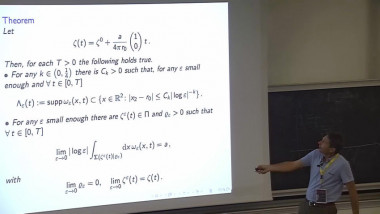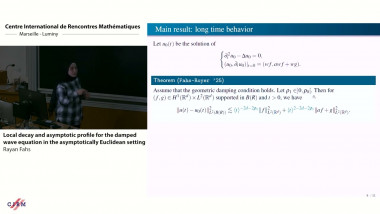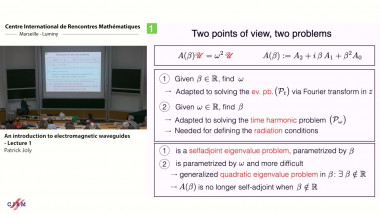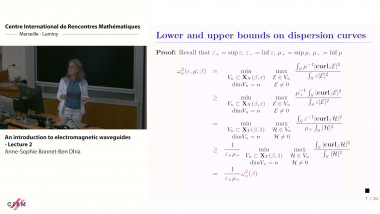Apparaît dans la collection : Inhomogeneous Flows: Asymptotic Models and Interfaces Evolution / Fluides inhomogènes : modèles asymptotiques et évolution d'interfaces
A common way to prove global well-posedness of free boundary problems for incompressible viscous fluids is to transform the equations governing the fluid motion to a fixed domain with respect to the time variable. An elegant and physically reasonable way to do this is to introduce Lagrangian coordinates. These coordinates are given by the transformation rule
$x(t)=\xi +\int_{0}^{t}u(\tau ,\xi ) d\tau $
where $u(\tau ,\xi )$ is the velocity vector of the fluid particle at time $\tau$ that initially started at position $\xi$. The variable $x(t)$ is then the so-called Eulerian variable and belongs to the coordinate frame where the domain that is occupied by the fluid moves with time.The variable $\xi$ is the Lagrangian variable that belongs to time fixed variables. In these coordinates the fluid only occupies the domain $\Omega_{0}$ that is occupied at initial time t = 0.
To prove a global existence result for such a problem, it is important to guarantee the invertibility of this coordinate transform globally in time. By virtue of the inverse function theorem, this is the case if
$\nabla_{\xi }x(t)=Id+\int_{0}^{t}\nabla_{\xi }u(\tau ,\xi )d\tau $
is invertible. By using a Neumann series argument, this is invertible, if the integral termon the right-hand side is small in $L^{\infty }(\Omega _{0})$. Thus, it is important to have a global control of this $L^{1}$-time integral with values in $L^{\infty }(\Omega _{0})$. If the domain is bounded, this can be controlled by exponential decay properties of the corresponding semigroup operators that describe the motion of the linearized fluid equation. On unbounded domains, however, these decay properties are not true anymore. While there are technical possibilities to fix these problems if the boundary is compact, these fixes cease to work if the boundary is non-compact.
As a model problem, we consider the case where $\Omega _{0}$ is the upper half-space. To obtain estimates of the $L^{1}$-time integral we use the theorem of Da Prato and Grisvard of 1975 about maximal regularity in real interpolation spaces. The need of global in timecontrol, however, makes it necessary to work out a version of this theorem that involves “homogeneous” estimates only (this was also done in the book of Markus Haase). In the talk, we show how to obtain this global Lagrangian coordinate transform from this theorem of Da Prato and Grisvard.
















